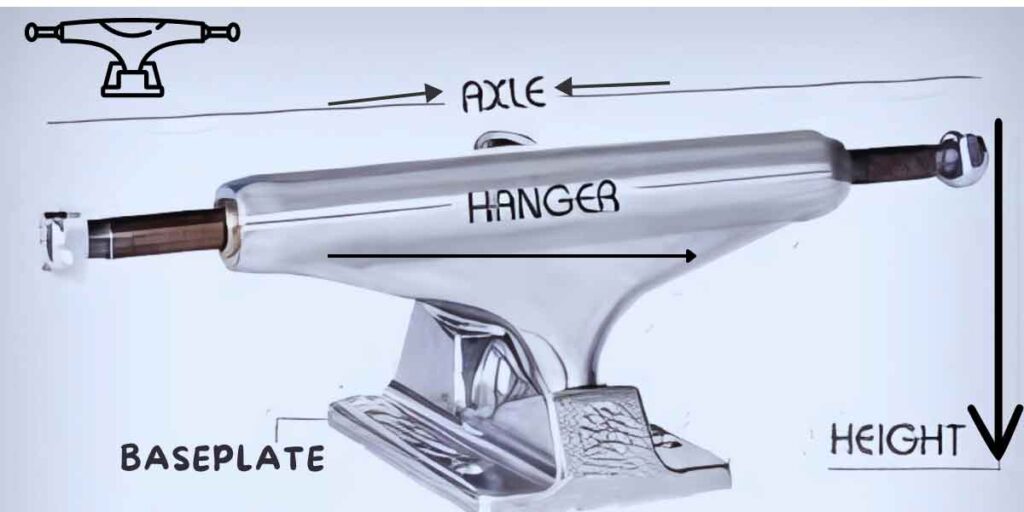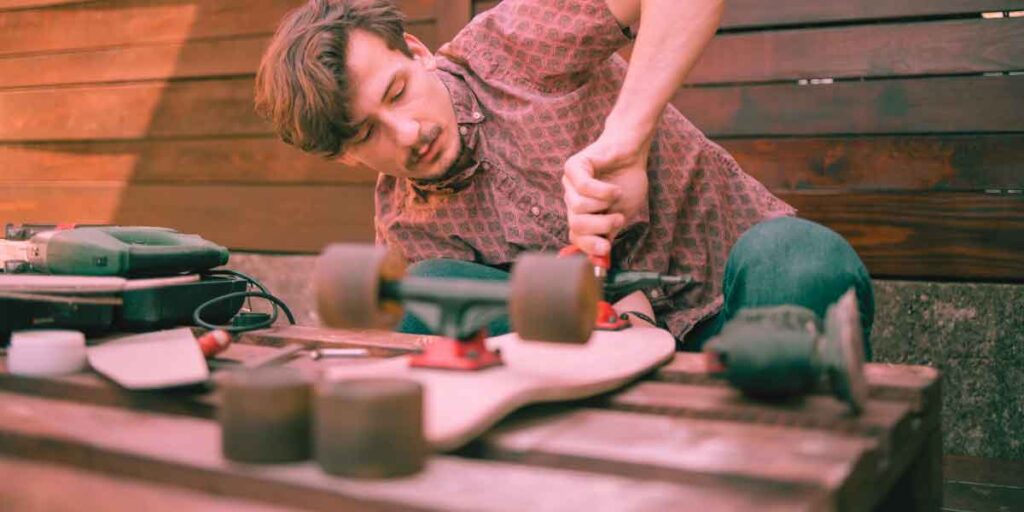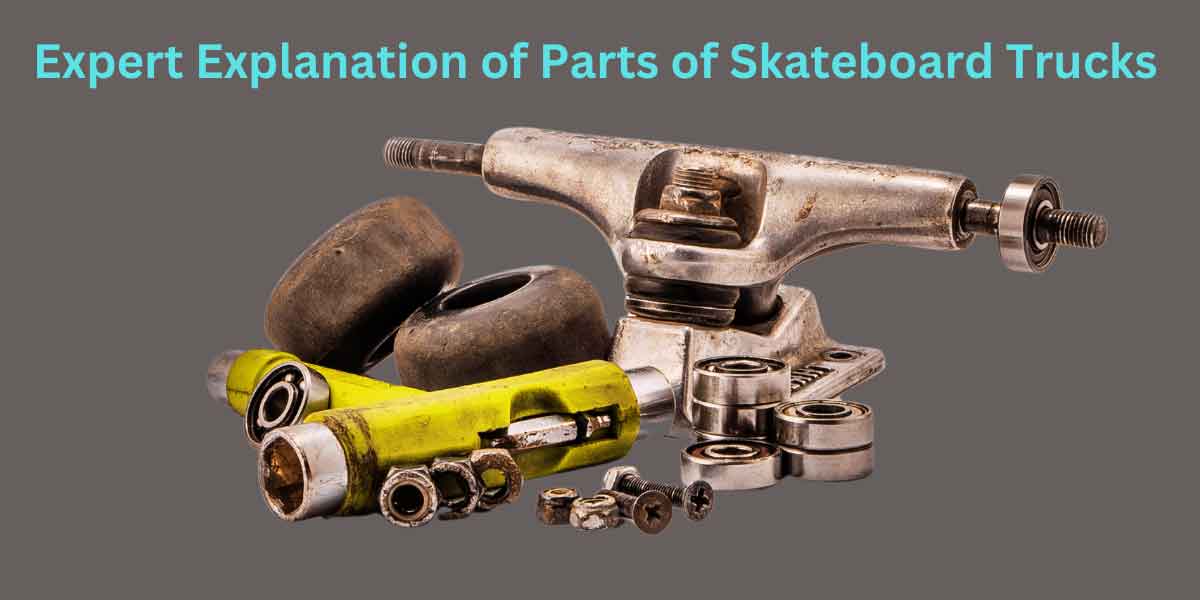The parts of skateboard trucks include the hanger, baseplate, kingpin, bushings, and axle. These components ensure stability and control.
Skateboard trucks are very essential for a smooth and controlled ride. They connect the deck to the wheels and allow for turning and maneuvering. The hanger, typically made of aluminum, holds the axle and supports the wheels. The baseplate secures the truck to the skateboard deck.
The kingpin is a central bolt that holds the hanger and baseplate together, allowing for movement. Bushings, made of rubber or urethane, cushion the truck’s turning motion. The axle, running through the hanger, attaches the wheels. So, it is important to understand their functions for ideal skateboarding.
The Anatomy of Skateboard Trucks
Skateboard trucks are metal T-shaped pieces mounted on the underside of the deck. They play a vital role in turning, stability, and overall control. Let’s break down the main components:
Truck Baseplate
The truck baseplate is a crucial part of a skateboard truck. It connects the truck to the deck. It provides stability and support during rides. You need to understand its parts to help you choose the right setup.
Mounting Holes
The baseplate has mounting holes for attaching to the deck. Usually, there are either four or six holes. The pattern can be standard or old school.
- Standard pattern: Fits most modern decks
- Old school pattern: Fits vintage or special decks
Ensure the holes align with your deck’s pattern. This guarantees a secure fit.
The pivot cup is a small but essential part. It sits in the baseplate. It holds the pivot point of the hanger. This helps in smooth turns and stability.
| Material | Durability |
| Rubber | High |
| Plastic | Medium |
Always check the pivot cup for wear and tear. Replace it if necessary to maintain performance.

Hanger
The hanger is a crucial part of the skateboard truck. It is the T-shaped metal piece that holds the axle. The hanger affects your skateboard’s stability and performance.
The axle is the long rod that runs through the hanger. It holds the wheels in a specific place. The axle’s width should match your skateboard deck. A wider axle gives more stability. A narrower axle allows sharper turns.
The kingpin is a large bolt that holds the truck together. It runs through the baseplate and hanger. The kingpin affects how tight or loose your trucks feel. Tightening the kingpin makes the skateboard more stable. Loosening it allows for easier turns.
| Part | Function |
| Hanger | Supports the axle and wheels |
| Axle | Holds the wheels in place |
| Kingpin | Connects the baseplate and hanger |
Some maintenance of the parts
- Check your hanger for cracks.
- Ensure the axle is straight.
- Tighten or loosen the kingpin for comfort.
Bushings
Bushings are small rubber rings. They are very important for your skateboard’s performance. They allow the trucks to turn smoothly. Bushings come in different shapes and hardness levels. They really affect how your skateboard feels and responds.
Top Bushing
The top bushing sits above the hanger. It helps control the board’s responsiveness. Softer bushings make the board turn easier. Harder bushings give more stability. The shape of the top bushing also matters. Conical bushings offer quick turns. Barrel bushings provide more support and stability.
| Bushing Shape | Characteristics |
| Conical | Quick turns, less stability |
| Barrel | More support, greater stability |
Bottom Bushing
The bottom bushing is below the hanger. This bushing handles most of the weight. It provides the main support for the skateboard. Like the top bushing, its hardness and shape affect performance. A harder bottom bushing means more stability. A softer one means easier turns.
Skateboarders often experiment with different bushings. Finding the right setup is the main key. It depends on your style and preference. Beginners might prefer softer bushings. Experienced skaters might choose harder ones for stability. The right bushings can make a big difference.
Kingpin
The Kingpin is a crucial part of skateboard trucks. It holds the truck assembly together and is essential for stability and control. Understanding its components can help you maintain and customize your skateboard for the best performance.
Kingpin Nut
The Kingpin Nut secures the kingpin bolt in place. It ensures the trucks stay tight and stable. This nut is found at the base of the truck. Regular checks are necessary to make sure it’s not loose. A loose kingpin nut can cause wobbly rides and reduce control.
| Feature | Importance |
| Material | Durable metals like steel |
| Size | Standardized for different trucks |
Kingpin Bolt
The Kingpin Bolt is the central piece connecting the hanger to the baseplate. This bolt needs to be sturdy and reliable. It’s often made from high-strength steel. The kingpin bolt takes a lot of stress during tricks and turns. Keeping it in good condition is key to smooth rides and safe skating.
- Check for cracks or wear
- Replace if bent or damaged
- Ensure it’s tightly secured
Understanding these parts helps you maintain your skateboard better. Regular maintenance ensures longer-lasting trucks and a safer ride.

Axle
The axle is a critical part of skateboard trucks. It is the rod that runs through the hanger. The axle holds the wheels in place. It must be strong and durable. This part ensures smooth and safe rides. Let’s look at the specific components of the axle.
Axle Nuts
The axle nuts secure the wheels onto the axle. These nuts are usually made of steel. They are essential for keeping the wheels in the right place. Without axle nuts, the wheels would fall off. Always check the tightness of your axle nuts. Loose nuts can cause accidents. Here’s a quick overview:
| Feature | Description |
| Material | Steel |
| Function | Secures wheels |
| Importance | Prevents wheel detachment |
Axle Washers
Axle washers are small but vital. They sit between the axle nut and the bearings. Their job is to reduce friction. This helps the wheels spin smoothly. They also protect the bearings from damage. Without washers, the bearings would wear out faster. Here’s what you need to know:
- Material: Usually made of metal or plastic.
- Function: Reduces friction and protects bearings.
- Placement: Sits between axle nut and bearings.
Pivot Cup
The pivot cup is a small yet crucial part of skateboard trucks. It helps ensure smooth turning and stability. Let’s dive into its materials and function.
Materials
Pivot cups are made from various materials. The most common include:
- Plastic: Affordable and durable, but wears out quickly.
- Rubber: Offers better flexibility and shock absorption.
- Urethane: Provides a perfect balance of durability and flexibility.
Each material has its pros and cons. Skaters often choose based on their personal preferences and skating style.
Function
The pivot cup plays a key role in skateboard trucks:
- It holds the pivot point of the truck’s hanger.
- The pivot cup allows smooth pivoting during turns.
- It reduces friction between metal parts.
- This part enhances the stability of the skateboard.
A well-maintained pivot cup can make a big difference. It ensures your skateboard rides smoothly and handles turns effectively.
| Material | Durability | Flexibility |
| Plastic | Medium | Low |
| Rubber | Medium-High | High |
| Urethane | High | Medium-High |
Choosing the right pivot cup material can enhance your skating experience. Experiment with different types to find what suits you best.
Riser Pads
Riser pads are small rectangular pieces placed between the skateboard deck and trucks. They reduce the impact of hard landings. Riser pads come in various thicknesses and materials. Besides, they provide additional support and height.
Shock Absorption
Riser pads are excellent for shock absorption. They cushion your skateboard during jumps and tricks. This reduces the strain on your deck. It also protects your feet and legs from harsh impacts.
Skateboards without riser pads may experience more wear and tear. Using riser pads prolongs the life of your skateboard. They make your ride smoother and more enjoyable.
Height Adjustment
Riser pads help with height adjustment. They can raise your skateboard deck by a few millimeters. This helps prevent wheel bite, which is when the wheels touch the deck during sharp turns.
Adjusting the height allows riser pads to accommodate larger wheels. Larger wheels can provide a faster and smoother ride. So, you should not make any mistake in choosing the right thickness of riser pads.
| Riser Pad Thickness | Effect on Ride |
|---|---|
| 1/8 inch | Minimal height adjustment, reduces minor vibrations |
| 1/4 inch | Moderate height adjustment, better shock absorption |
| 1/2 inch | Maximum height adjustment, excellent shock absorption |
Choosing the right riser pad thickness depends on your skating style. Experiment with different sizes to find the perfect match.
Speed Rings
Speed rings are small but vital parts of skateboard trucks. They ensure smooth rides and protect bearings. If you understand their role, you can maintain your skateboard.
Placement
Speed rings are placed on the axle of the skateboard truck. Each axle has two-speed rings, one on each side of the wheel.
| Component | Location |
|---|---|
| Speed Ring | Axle, beside the wheel |
The first ring is between the hanger and the wheel. The second ring is between the nut and the wheel.
Purpose
- Speed rings reduce friction between the wheel and the truck. They provide a smooth rotation for the wheels.
- Protect bearings from wear and tear.
- Enhance speed and performance.
- Increase the lifespan of your skateboard wheels.
- Without speed rings, wheels may not spin freely. This can slow down the skateboard and cause damage.

Choosing the Right Skateboard Trucks
When selecting skateboard trucks, consider the width, height, and type that best suits your riding style.
- Width: Trucks should match the width of your deck. Wider trucks provide more stability, while narrower trucks offer quicker turns.
- Height: Trucks come in low, mid, and high profiles. Low trucks are great for street skating and tricks, mid trucks are versatile, and high trucks are suitable for cruising and carving.
- Kingpin Type: Standard kingpins are common for street skating. Reverse kingpins are preferred for carving and downhill riding due to their smoother turning radius.
NB: These tips are also applicable when choosing longboard trucks.
Skateboard Truck Maintenance Tips
Regular maintenance of your skateboard trucks can prolong their life and ensure a smooth ride. Check the tightness of the kingpin nut, inspect for cracks or damage, and replace worn-out bushings.
Conclusion
Understanding the parts of skateboard trucks is essential for a smoother ride. Each component plays a crucial role. From the kingpin to the bushings, each part affects performance.
It will help you make informed decisions about customization and maintenance. Understanding each part of your skateboard helps you skate better. Keep your skateboard trucks in top condition for an optimal skateboarding experience. Enjoy the ride!
FAQs About Skateboard Trucks
What are skateboard trucks made of?
Skateboard trucks are typically made of metals like aluminum, steel, titanium, and sometimes magnesium. These materials offer a balance between strength and weight. These make them durable for different skating styles.
How do I choose the right truck size?
The size of your trucks should match the width of your skateboard deck. For example, if you have an 8.0” deck, you should get trucks that are around 8.0” wide. This ensures optimal stability and performance.
What is the difference between high, mid, and low trucks?
The height of your trucks affects your ride:
1. Low trucks (46-49mm) offer more stability and are great for flip tricks, but can increase the risk of wheel bite.
2. Mid trucks (50-53mm) are versatile and suitable for all-around skating.
3. High trucks (53.5-58mm) provide better clearance for larger wheels and are ideal for cruising and carving.
Should I ride with tight or loose trucks?
It depends on your style:
1. Tight trucks provide more stability and are better for beginners or skaters focusing on tricks that require balance.
2. Loose trucks allow for easier turning and carving. So it is great for more experienced skaters who enjoy street cruising and tricks

